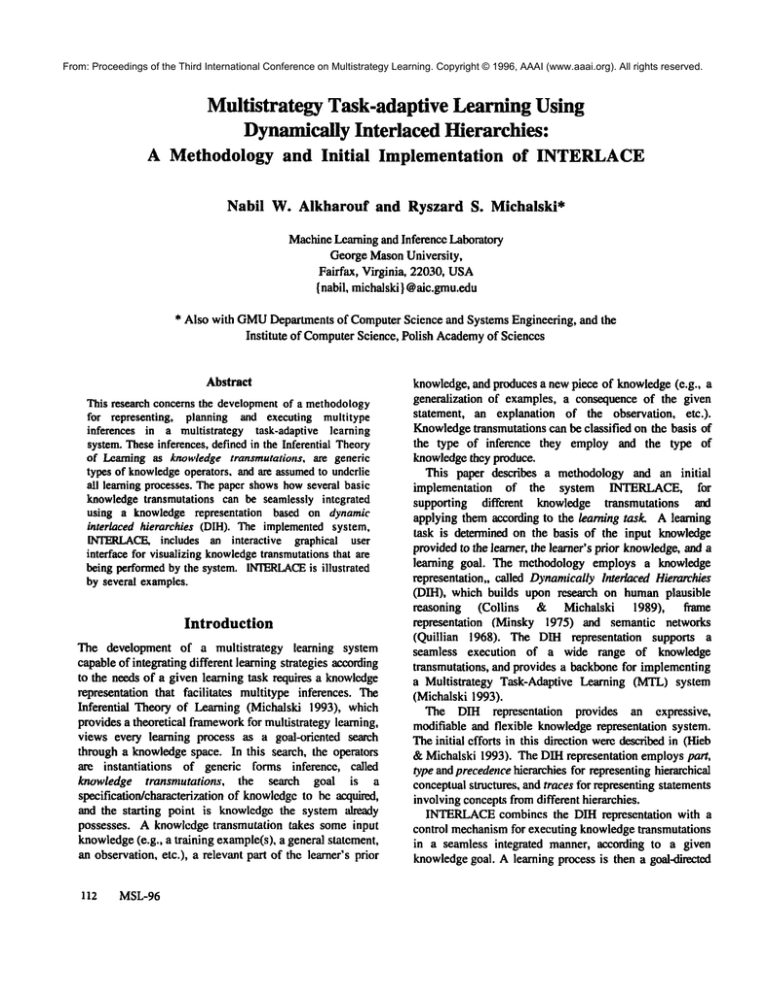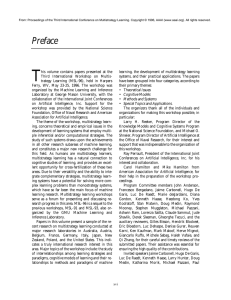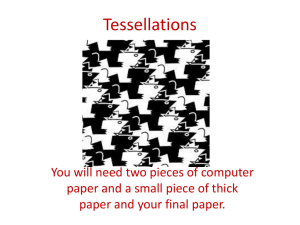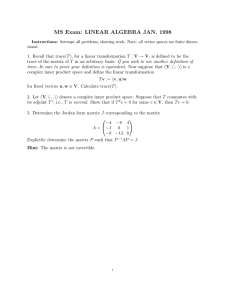
From: Proceedings of the Third International Conference on Multistrategy Learning. Copyright © 1996, AAAI (www.aaai.org). All rights reserved.
Multistrategy Task-adaptive Learning Using
Dynamically Interlaced Hierarchies:
A Methodology and Initial Implementation of INTERLACE
Nabil
W. Alkharouf
and Ryszard S. Michalski*
MachineLearningandInference Laboratory
GeorgeMasonUniversity,
Fairfax, Virginia, 22030,USA
{ nabil, michalski} @aic.gmu.edu
* Also with GMUDepartments of Computer Science and Systems Engineering,
Institute of Computer Science, Polish Academyof Sciences
Abstract
This research concernsthe development
of a methodology
for representing, planning and executing multitype
inferences in a multistrategy task-adaptive learning
system.Theseinferences,definedin the InferentialTheory
of Learningas knowledgetransmutations,are generic
typesof knowledge
operators,andare assumed
to underlie
all learningprocesses.Thepapershowshowseveral basic
knowledge
transmutationscan be seamlesslyintegrated
using a knowledgerepresentation based on dynamic
interlaced hierarchies (DIH). Theimplemented
system,
INTERLACE,
includes an interactive graphical user
interfacefor visualizingknowledge
transmutations
that are
being performedby the system.INTERLACE
is illustrated
by several examples.
Introduction
The developmentof a multistrategy learning system
capableof integratingdifferentlearningstrategies according
to the needsof a givenlearning task requires a knowledge
representation that facilitates multitypeinferences. The
Inferential Theoryof Learning(Michalski 1993), which
providesa theoretical framework
for multistrategylearning,
views every learning process as a goal-oriented search
througha knowledgespace. In this search, the operators
are instantiations of generic forms inference, called
knowledge transmutations, the search goal is a
specification/characterizationof knowledge
to be acquired,
and the starting point is knowledgethe system already
possesses. A knowledgetransmutation takes someinput
knowledge
(e.g., a training example(s),a generalstatement,
an observation,etc.), a relevantpart of the learner’s prior
112 MSL-96
and the
knowledge,andproducesa newpiece of knowledge
(e.g.,
generalization of examples,a consequenceof the given
statement, an explanation of the observation, etc.).
Knowledge
transmutationscan be classified on the basis of
the type of inference they employ and the type of
knowledge
they produce.
This paper describes a methodologyand an initial
implementation of the system INTERLACE,for
supporting different knowledge transmutations and
applyingthemaccordingto the learning task. A learning
task is determinedon the basis of the input knowledge
providedto the learner, the learner’sprior knowledge,
anda
learning goal. The methodologyemploys a knowledge
representation,, called Dynamically
InterlacedHierarchies
(DIH), whichbuilds uponresearch on humanplausible
reasoning (Collins & Micbalski 1989), frame
representation (Minsky 1975) and semantic networks
(Quillian 1968). The DIHrepresentation supports
seamless execution of a wide range of knowledge
transmutations,and providesa backbonefor implementing
a Multistrategy Task-AdaptiveLearning (MTL)system
(Michalski1993).
The DIH representation provides an expressive,
modifiableandflexible knowledge
representation system.
Theinitial efforts in this directionweredescribedin (Hieb
& Michalski1993). TheDIHrepresentation employspart,
type andprecedence
hierarchiesfor representinghierarchical
conceptual
structure.K,andtracesfor representingstatements
involvingconcepL~
fromdifferent hierarchies.
INTERLACE
combines the DIHrepresentation with a
control mechanism
for executingknowledge
transmutations
in a seamless integrated manner,according to a given
knowledge
goal. Alearningprocessis then a goal-directed
From: Proceedings of the Third International Conference on Multistrategy Learning. Copyright © 1996, AAAI (www.aaai.org). All rights reserved.
transformation of knowledgethat is carded out through
inferential processes embodiedin knowledgetransmutation
operators.
The INTERLACE
system consists of three interacting
modules, a knowledgebase for DIHhierarchies, traces and
transmutations, a goal-driven planner for generating
plausible sequences of transmutations in order to achieve a
given goal, and a graphical user interface for visualizing
knowledge transmutations.
The implemented system
includes capabilities for such transmutations as inductive
generalization, deductive specialization, abstraction and
similization,
and their counterparts,
deductive
generalization, inductive specialization, concretion and
dissimilization. It also allows for the graphical creation,
modificationand deletion of DIHhierarchies and traces.
Related Research
One of the important aspects of the Inferential Theory of
Learning (ITL) is that provides an approach to analyzing
and describing the competenceof learning strategies, that
is, their logical capabilities. Theoryviews every learning
process as a search through a knowledgespace defined by
the employed knowledgerepresentation, and guided by a
learning goal. The search operators, instantiations of
transmutations, represent different types of inference or
knowledge transformation.
Basic
knowledge
transmutations include generalization,
abstraction,
explanation, selection, association,
similization,
agglomeration, characterization, and their counterparts,
specialization, concretion, prediction,
generation,,
disassociation, dissimilization,
decomposition vvd
discrimination (Michalski 1994).
Accordingto ITL, to instill learning capabilities in a
multipurpose intelligent agent, one needs to implementin
it the ability to conduct multiple types of inference (in
general,
any type of knowledge derivation
or
transformation) and the ability to store and retrieve
knowledge. This observation forms the basic premise of
the theory, which can be succinctly stated in the following
"equation":
Learning ffi Inference + Memory
This theory is conceptually close to Newell’s ideas of
about knowledge-level systems (Newell 1994). ITL
abstracts from the mediumthat transforms knowledge, and
concentrates on the type of knowledgetransformations that
occur in learning processes. Therefore, it can be used, in
principle, for analyzing any type of learning. In this paper,
ITL is used as a conceptual basis for implementing a
multistrategy task adaptive learning.
Research on multistrategy task-adaptive learning (MTL)
systems alms at synergistically integrating a wide range of
learning strategies in order to perform different leandng
tasks. A learning task is defmedby the available input to
the learning system, learner’s prior knowledge, nd a
learning goal. The proposedsystemis called task-adaptive,
because it is supposed to dynamically combinedifferent
learning strategies so that it can perform a given learning
task (Michalski 1993, 1994; Michalski & Ram1995).
The system is inherently goal-dependent, because it does
not assumethat the learning process is just a search for a
generalization of examples, as often done in machine
learning, but can, in principle, search for any kind
knowledge that is desirable by the learner (Michalski
1994).
Researchon task-adaptive learning is conceptuallyrelated
to research on integrated learning, (e.g., Bergadano,
Giordana &Saitta 1991), and goal-driven learning (e.g.,
Hunter 1990; I.eake & Ram1995; Ram& Leake 1995).
In general, multistrategy learning systems range from
loosely coupled systems that consist of several learning
modulescoordinating to achieve the learning task to tightly
coupled systems that deeply and synergistically integrate
inferential learning strategies in order to achievethe desinxi
learning performance. Examples of tightly ("deeply")
integrated learning systems include the discussed learning
system (MTL-DIH)
and a related system based on plausible
justification trees (Tecuci 1993).
Figure 1 presents a general schemaof a multistrategy
task-adaptive learning system based on D1Hknowledge
representation (a MTL-DIH
system). The learning task
defined by the input DIH traces, relevant background
knowledge in the form of DIHhierarchies and existing
traces through the hie~’archies, and a learning goal (in
general, it can be a set of goals). A multitype inference
engine utilizes
DIH transmutations
as knowledge
generation operators under the supervision of a control and
planning subsystem.
DynamicallyInterlaced Hierarchies
The idea of the knowledge representation
based on
Dynamically Interlaced Hierarchies stems from the
observation that someknowledgeis more or less stable and
other knowledgeis acquired incrementally using the stable
knowledgeas hooks. In (Collins & Michalski 1989), this
"stable" knowledge is represented by type and part
hierarchies.
Initial
ideas and a method for the
implementation of Dynamically Interlaced Hierarchies
(DIH) was presented in (Hieb &Michalski 1993). The
representation is conceptually related to semantic networks
(Quillian 1968), but is has some important distinctive
features, designed to facilitate a conceptual simplicy of
representation and performingdiverse forms of inference in
a uniform way.
Alkharouf
113
From: Proceedings of the Third International Conference on Multistrategy Learning. Copyright © 1996, AAAI (www.aaai.org). All rights reserved.
External
°
S
I
e
I
World
Control ,~, Planning
I Son--o
I Aototors
1
I ii
E
v
a
I
C
t
U
a
i
o
n
T
t
i
Learning Goals
Mutitype Knowledge Base
- DIH Hierarchies
- DIH Traces
o
n
T
Figure 1. A general schemafor a multistrategy task-adaptive learning system based on the DIHknowledgerepresentation.
In D1Hknowledge is partitioned into a static and
dynamicpart. The static part represents relatively stable
knowledgeorganized into concept hierarchies such as part,
type and precedencehierarchies, each hierarchy organizes its
concept nodes from a certain context or viewpoint, with the
possibility of concept nodes participating in morethan one
hierarchy. The dynamic part represents knowledge that
changesrelatively frequently. This knowledgeis represented
by traces that are paths linking nodesof different hierarchies
in order to represent single statements.
DIHprovides a suitable knowledgerepresentation for
facilitating multitype inference in multistrategy learning
systems that require an expressive, modifiable and flexible
representation
language. Initial
work on the DIH
representation was presented in (Hieb &Michalski 1993).
INTERLACE
INTERLACE
is the core of the MTL-DIHmultistrategy
learning system. It consists of three interacting modules
ma knowledgebase, a goal driven planner and a graphical
user interface. To implement INTERLACE,
we needed a
language that wouldfacilitate the construction of concept
hierarchies and makinglinks amongthem. For this purpose
we chose LIFE programming language, originally
conceived at MCC.
LIFE is a synthesis of three different programming
paradigms: logic programming, functional programming,
and object-oriented programming.It is a declarative logicbased languagethat can be seen as a constraint language. It
derives its syntax and resolution methodfrom Prolog. It
uses Z-terms as its basic data structures, and unification
and matchingas its basic operations.
114
MSL-96
LIFE semantically extends PROLOG
in two ways:
1) Herbrandterms are replaced by Z-terms.
2) It includes call by matching (Prolog only supports
call by unification).
As a programming language LIFE provides clean and
elegant solutions to a numberof Proiog’s deficiencies. It
includes functions (correct arithmetic), object-orientation,
C-like records, expandabledata-structures (arrays and hashtables),
types and multiple inheritance,
correct
manipulation of cyclic structures,
coroutines and
constraints, global variables, clean destructive assignment,
persistent data structures.
Representation
of DIH Hierarchies
and Traces
As mentionedearlier, DIHhierarchies represent relatively
stable background knowledge. Such knowledgeconsists of
conceptsorganized into hierarchies of different kinds, such
as type, part and precedence hierarchies. A DIHnode is
representedin LIFEas a sort, an identifier standingfor a set
of objects. A sort corresponds intuitively to a type in a
traditional programming
language, or a class in an objectoriented programminglanguage.
Sorts arc organizedinto a hierarchy througha set of sort
declarations (using the <1 operation). For example, the
navy_aireraft type hierarchy in Figure 2 is declared in the
following manner:
combat_aircraft<1 navy_aircraft
fuel_aireraft <1 navy_aircraft
service_aircraft <1 navy_aircraft
f16 <1 comhat_aircraft
tomcat<1 combat__aircraft
From: Proceedings of the Third International Conference on Multistrategy Learning. Copyright © 1996, AAAI (www.aaai.org). All rights reserved.
DIHtraces represent "dynamic" knowledgethat changes
relatively frequently. A trace roughly stands of a statement,
and is a path connectingnodesof different hierarchies. DIH
traces are represented using X-terms, the LIFE’s basic data
structure. Each X-termhas the following syntax:
root_sort (label_l => sort, label_2 => sort .....
Eachsort including the root sort is a part of a hierarchy.
Eachsort can be further refined using the hierarchy that is
also apart of type. This formsa basis for the functionality
of DIHtransmutations described below. For example, the
DIHtrace expressing the statement "Someaircraft carriers
in Norfolkhavefuel aircraft" is representedas:
aircraft_carrier(quantifiex =>some,location ffi>
norfolk, navy_aircraft => fuel),
wherea/rcrafl_car’,’/er is the trace argument(root sort),
quantifier, location, and navy_aircraft are viewed as
descriptors applied to the trace argument. Adding
knowledgeto the DIHrepresentation is done by creating
hierarchies and specifying traces that express statements
involvingnodesof different hierarchies.
Representation
of DIH Transmutations
Wewill shownowthat several basic knowledgegeneration
transmutations, as described in the Inferential Theoryof
Learning (Michalski 1991, 1992, 1993), can be easily
performedin DIH,specifically, just by movingsomelinks.
The transmutations include generalization, abstraction,
explanation and similization, and their counterparts,
specialization, concretion, prediction and dissimilization,
respectively. The DIHsystem currently implements six
transmutations:
QGEN:
Quantification-based Generalization
QSPEC:
Quantification-based Specialization
AGEN:Argument-based Generalization
ASPEC:Argument-based Inductive Specialization
ABST: Abstraction
CONC: Concretion
By repeating these transmutations
in different
combinations, the system can perform a wide range of
inferences. Every transmutation has the following syntax:
TransType(I_TRACE, CONTEXT,O_TRACE),
where I trace is an input trace, and O_trace is an output
trace (a trace generatedby a transmutation).
An inference step performed by a transmutation can be
depicted graphically as a movementof traces along some
nodes of the hierarchies.
To illustrate
specific
transmutations (operators) performed by INTERLACE,
suppose that given is an input statement: "SomeNorfolk
aircraft cardersare fuel carders."
This statement is representedby a trace:
I_TRACE: aircmt~carrier
(quantifier
=> some,
location => norfolk, navy_aircraft => fuel).
The order of arguments for the trace interpretation is
defined by a schemahierarchy, SH, shownin Figure 2.
For the given input,
the QGEN operator
(Quantification-basedGeneralization)producesa trace:
O_TRACE:
[aircraft_carder
(quantifier --> most,
location => norfolk, navy_aircraft => fuel)] (Figure
Given the same input,
the QSPEC operator
(Quantification-basedSpecialization), produces:
O_TRACE= [~carrier
(quantifier
=> one,
location => norfolk, navy_aircraft => fuel)].
Again, given the same input, the AGENtransmutation
(Argument-basedGeneralization) produces:
O_TRACE=[navy_hattleship(quantifier=>some,
location => united_states, uavy_aircraft ffi> fuel)]
(Figure 2).
ASPEC(Argument-based specialization
can produce
one of several alternatives, dependingon merit ixzrwneters
(Colfins & Michalski 1989). One of them (Figure
O_TRACE
ffi [iowa_class(quantifier => some, location
=>united__states,navy_aircraftffi> fuel)].
ABST(Abstraction) produces:
O_TRACE
= [aircraft_carder(quantify"
=> some,
location => united_states, navy_aircraft => fuel)]
(Figure 4).
CONC(Concretion),
another form of inductive
inference, produces(amongother plausible alternatives):
O_TRACE
= [aircraft_carrier(quantifier
=> some,
location => united_states, navy_aircraft => b677)
(Figure 5).
In principle, all the above transmutaions can represent
deductive or inductive inference, depending on the
combination of nodes in a trace and on what nodes are
moved(Michalski 1994).
Goal.Driven
Learning
based on DIH
The idea behind the DIH-basedgoal-driven learning is to
apply a sequence of transmutations that transfer a given
input (one or moretraces) into one or more output traces
that satisfy a learning goal. A learning goal is
specification of knowledgethat the learner wants to aquire.
A learning goal is generated by a performancesystem, for
example,as a request for someknowledge,as a result of an
impass in problem solving (Newell 1994), etc. A goal
specification is expressed as a trace. A goal trace may
include high level nodes whosechildren are to be learned, or
nodes indicating the type of knowledgeto be acquired.
Learning goals can be classified into two categories:
domainspecific and domainindependent (Michalski & Ram
1995). Learning in INTERLACE
system is designed to
handle both domainspecific and domainindependentgoals.
Alkharouf l 15
From: Proceedings of the Third International Conference on Multistrategy Learning. Copyright © 1996, AAAI (www.aaai.org). All rights reserved.
INDUCTIVE GENERALIZATION
Input:.
SomeNorfolk aircraft-carriers
have fuel aircraft
_B~........ ~.~jL..=..~_tLo
.................................................
~ .hj.~.r .~.~.=.h~
Output:.
Maybemost Norfolk aircra~carriers
have fuel aircraft
Figure 2. An example of a quantification-based
inductive generalization.
INDUCTIVE SPECIALIZATION
Input:.
SomeUnited States aircraft-carriershave
fuel aircraft
BK:
Iowa class is a popular type of Navy Battleship
Output:. MaybesomeUnited States aircraft-carriers
of Iowa classhave fuel aircraft
116
MSL-96
From: Proceedings of the Third International Conference on Multistrategy Learning. Copyright © 1996, AAAI (www.aaai.org). All rights reserved.
ABSTRACTION
__N
_o~
o.Lk_Ls_p_
_a~_
oLL~.
u_njt
ed
..............................
Some
Norfolk
aircraft-carriers
have
aircraft
-fuel
)._K............
Input :
O u! put:
Some
U n/ted States aircraft-carriers haye fuel aircraft
: IowaClass
Figure 4. Anexampleof abstraction transmutation.
CONCRETION
Input:
BK:
Out put:
Some
U nited Stat es aircraft-carriers havefuel aircraft
A B-678 aircraft is a popular type of a fuel
MaybesomeUnited States oircrdt-carriers have B-678 aircraft
GunShip
IowaClass Oirollaa Class
AlaskaCkss
DakotaClass
%
FI6
B-677
B-678
Figure 5. An exampleof concretion transmutation.
Alkharouf
I 17
From: Proceedings of the Third International Conference on Multistrategy Learning. Copyright © 1996, AAAI (www.aaai.org). All rights reserved.
Domain Specific
Goals. Domain specific
goals
define knowledgethat is relevant in the given domain. The
task of the planner is to generate a sequence of
transmutations that produce knowledgethat satisifies the
given goal.
Such a process is invoked in INTERLACE
by:
Plan(I_TRACES, G_TRACES, CONTEXT,PLAN),
where
I_TRACES
-- a list of relevant input traces
G_TRACES
-- a goal trace (or a list of traces).
CONTEXT
-- a context for the process, specified by a
list of hierarchies within whichthe transmutationsare to be
performed)
PLAN-- a list of plausible transmutations that proof
the G_TRACES.
The planner determines which transmutation
is
appropriate for a given goal in the given contex Deductive
transmutations are favored over inductive transmutations
during the planning process.
To illustrate the process, let us consider:. I_TRACES
=
[Iowa_class(quantifier ffi> one, location => United_States,
aircraft_type
=> tomcat)
], and G_TRACES
[aircraft_carrier (quantifier ffi> most general, location =>
norfolk, aircraft_type => combat)]. The planning process
produces the following .qxluence
of plausible
transmutations to achieve the goal:
argument-based
deductivedenerafization from Iowa_classto aircraft_carrier,
abstraction
from tomcat to combat, two inductive
quantification-based generalizations -- from one to some,
and then to most, and an inductive concretion from
United_states to Norfolk.
Domain Independent Goals. Domain independent
goals require the system to determine somegeneral type of
knowledge, e.g., a generalization
of examples, a
hierarchical classification of given facts, an explanationfor
an observation, etc.). Such goals are handled by designated
procedures. In the absence of a more specific goal, the
system executes the universal learning goal -- derive all
plausible knowledgethat can be learned from a given input.
The universal goal is executed by analyzing the relationship
between an input trace and background knowledge, and
performingsteps dependenton the result of this analysis, as
illustrated in Figure 6 (Michalski1994).
INTERLACEGraphical
Interface
An interactive
graphical interface using OSF MOTIF
(Johnson 1993; Young1994) was utilized for the creation,
modification and deletion of DIHhierarchies and traces, all
actions performedby the user in the graphical interface me
118
MSL-96
reflected in the underlying knowledgebase. The interactive
graphical interface has the followingfeatures:
Hierarchy Creation. Create a node anywhere on the
screen. Twotypes of arcs are defined: Undirected and
Directed. Eachof the abovearcs can be in solid line style or
on-off dash style. Hierarchiesare created by using undirected
solid line style arcs. Bya repeatedapplication of "create an
arc" between two nodes, one can create a hierarchy. The
systemallows a user to create multiple hierarchies within a
screon.
Trace Creation. Traces are created by using directed onoff dash arcs connecting nodes from separate hierarchies.
The tip of the directed on-off dash arc designates the uace
argument.The tail of the directed on-off dash arc designates
the referent.
Hierarchy Movement and Orientation
¯ Hierarchies can be viewedvertically and horizontally.
¯ Hierarchies can be centered on the screen
¯ Hierarchies can be selected and movedaround on the
~’reen
¯ A single node within a hierarchy can be movedaround.
¯ Arcs can be movedto reflect newrelationships between
two nodes.
¯
Subhierarchies can be selected and movedaround.
Hierarchy and Trace Deletion
¯
Delete a single selected node, this in turn deletes any
arcs associated with the deleted nodes
¯
Delete a set of selected nodes, this in turn deletes any
arcs associated with the deleted nodes
¯
Deletean arc
¯ Delete selected arcs
¯ Delete the wholehierarchy
Conclusion
This paper descn~bedan ongoingresearch on the design and
implementationof a task-adaptive multistrategy learning
system "based on the DIHknowledgerepresentation. The
DIH representation was shown to be very useful for
performing a wide range of knowledge generation
transmutations that are required in multistrategy taskadaptive learning.
Amongthe most important objectives for future research
is howto represent different kinds of goals, and howto
determine most appropriate transmutations in pursuing the
given learning goal.
From: Proceedings of the Third International Conference on Multistrategy Learning. Copyright © 1996, AAAI (www.aaai.org). All rights reserved.
Input Trace
J
Input Trace
matchesexactly
BK ?
Deduceuseful
consequences
T
UpdateTrace Merit ]
Parameters
l
T
betweenInput trace
and BK
Discard trace
I
[
F
F
T
©ontradicts BK
morecredible
KnowledgeBase
Figure 6. A simplified schemafor muitistrategy learning pursuing the universal learning goal.
Acknowledgments
This research was done in the Machine Learning and
Inference Laboratory at George MasonUniversity. Authors
thank membersof the laboratory for valuable discussions
and criticism.
The Laboratory’s research is supported in part by the
National Science Foundation under grants DMI-9496192
and IRI-9020266, in part by the Office of Naval Research
under grant N00014-91-J-1351, in part by the Defense
Defense AdvancedResearch Projects Agency under grant
No. N00014-91-J-1854administered by the Office of Naval
Research, and in part by the Defense AdvancedResearch
Projects Agency under grants F49620-92-J-0549 and
F49620-95-1-0462,administered by the Air Force Office of
Scientific Research.
References
Bergadano, F., Giordana, A. and Saitta 1991. Machine
Learning: An integrated Frameworkand its Applications,
Ellis Horwood.
Collins A. and Michalski, R.S. 1989. Logic of Plausible
Reasoning: A Core Theory, Cognitive Science, vol. 13.
Hieb, M., Michalski,
R.S. 1993. Knowledge
Representation for Multistrategy Task-AdaptiveLearning:
DynamicallyInterlaced Hierarchies, In Michalski R.S. and
Tecuci, G. (Eds.), Proceedingsof the SecondInternational
Workshop on Multistrategy Learning, published and
distributed by MachineI_~ning and Inference Laboratory,
George MasonUniversity, Faiffax, VA.
Johnson-Laird, P.
University Press.
1983, Mental Models, Harvard
Alkharouf
119
From: Proceedings of the Third International Conference on Multistrategy Learning. Copyright © 1996, AAAI (www.aaai.org). All rights reserved.
Johnson, E. F., Reichard, K. 1993. Power Programming
in Motif, MISPress, SecondEdition.
Leake, D. and Ram, A. 1995. Learning, Goals, and
Learning Goals: A Perspective on Goal-Driven Learning,
Artificial Intelligence Review.
Michalski, R.S. 1993. Toward a Unifind Theory of
Learning: Multistrategy Task-adaptive Learning," in
Readings in Knowledge Acquisition and Learning:
Automating the Construction tout Improvementof Expert
Systems, B.G. Buchanan and D.C. Wilkins, Morgan
Kaufmann, San Mateo.
Michalski, R.S. 1993. Inferential Theory of Learning:
Developing Foundations for Multistrategy Learning, In R.
S. Michalski and G. Tccuci (Eds.), MachineLearning: A
Multistrategy Approach MorganKaufmannPublishers.
Michalski, R.S., Ram, A., 1995. Learning as GoalDriven Inference. In A. Ramand D. ~e (Eds.). Goa/Driven Learning, Bradford Books/MITPress, Cambridge,
MA.
120
MSL-96
Minsky, M. 1975. A Frameworkfor the representation of
knowledge; In P. Winston 0Sd.), The P.D’chology of
Computer Vision, NewYork: MCGraw-Hill.
Newell, A. 1994. Unified Theories of Cognition, "Harv~
University Press.
Quillian, M.R., Semantic Memory, in Minsky (Ed.).
Semantic Information Processing. Cambridge, MITPress,
1968.
Popper, K., Logic of Scientific
1959.
Discover’)’, NewYork,
Ram, A. and Leake, D. (Eds.) 1995. Goal-DrivenLearning,
Bradford Books/MITPress, Cambridge, MA.
Tecuci, G., 1993. An Inferential Based Frameworkfor
Multistrategy
Learning.
Machine Learning: A
Multistrategy Approach, MorganKaufmannPublishers.
Young, D., Pew, J., "The X Window System
Programmingand Applications with Xt", Prentice Hall,
First Edition.



